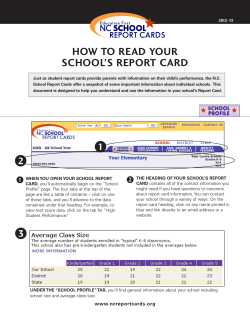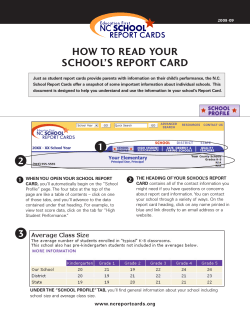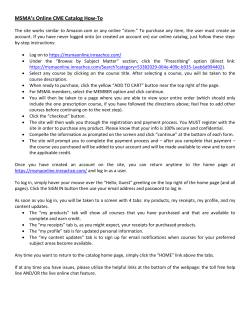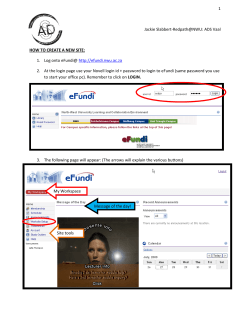
How to format your dissertation 04
04 How to format your dissertation This help sheet provides guidelines on how to format a project or dissertation. Please note that the specific details included in this help sheet are examples only. In all cases you should confirm with your lecturer or supervisor their exact formatting requirements. This may include specific fonts and font sizes, margins, line spacing etc. Many lecturers will also require your work to be bound. There are a variety of types of binding available. Self-service heat binding is available from the Learning Resources Centre (LRC) help desk on 1 South of the LRC. Other types of binding such as comb and spiral binding are available from the TAB Shop and other stationery shops located around London Road. Please check with your lecturer for their preferred binding type before submitting your work. Double space your work To double space text: 1) Click on the Home Tab. In the Editing group on the ribbon click on the arrow next to Select and choose Select All. This will select all the text in the document. Alternatively use the Ctrl+A keyboard shortcut to select all text. To do this hold down the Ctrl and A key at the same time. 2) On the Home or Page Layout tab, click the arrow on the bottom right of the Paragraph group to bring up the Paragraph dialogueue box. 3) From the Line Spacing drop-down menu (see page 2), select Double and click OK. You will see that all your text is now double-spaced. How to format your dissertation Exceptions The following should be changed to single spacing by selecting the relevant text and following the previous instructions, but selecting Single instead of Double. 1) Long quotations. 2) Table and figure captions, descriptions and footnotes. 3) List of references, literature cited, bibliography etc. 4) Some reference lists may be single-spaced but a double space should be added between each reference. Setting your margins If you are binding your dissertation, it is a good idea to set a larger margin on the lefthand side. However, some markers prefer that you set the margins equally. Check with your tutor/marker. To set your margins follow the steps below; 1) Select the Page Layout tab. 2) Click on Margins. 3) Select the required margin from the list or choose Custom Margins to create your own. Fonts As mentioned on page 1 you should check with your lecturer, supervisor or faculty whether a specific font and font size is required for your work. A standard font size of at least 12 is usually required. Generally speaking there are two types of fonts; serif fonts and sans serif fonts. Serif fonts such as Times New Roman have additional details on the strokes of the letters (see example below). Times New Roman 12pt Sans serif fonts such as Arial do not have these details. Arial 12pt Page | 2 How to format your dissertation Changing your font 1) Click on the Home Tab. In the Editing group, click on Select Select All. This will select all the text in the document. Alternatively use the Ctrl+A keyboard shortcut to select all text. 2) Under the Home Tab in the Font group use the drop-down menu and select your required font such as Arial or Times New Roman. In Word 2010 when you highlight a font type or size you will see a preview of how it looks on the screen. 3) Select “12” or your required size from the font size drop-down menu. Page Numbers Page numbering is relatively simple if you are producing a document which runs from pages 1 to 50. However if you have a title page, table of contents and an introduction you will not generally want page numbers (or at least not the same types of page numbers) to appear on all of these pages. Creating sections The first step is to divide your paper into sections that your computer will recognise. The first one will be the title page. It is easier to do this after you have created your title page text. 1) Go to the bottom of your title page and place your cursor after the very last word on the page. 2) On the Page Layout tab, in the Page Setup group, click Breaks. 3) Select Next Page, as shown in the picture. You have created a section break! Now the computer will see your title page as an individual section, separate from the rest of your document. If you have a table of contents, use the same method to place that in an individual section: type up the contents and then create a section break at the end. Page | 3 How to format your dissertation Inserting page numbers We will insert the page numbers in the footer of your document. In order to make sure that these display properly, make sure your Page Margins are set to their defaults. 1) Place the mouse cursor on the first page of your text, or the page where you want your page numbers to begin. 2) Go to the Insert tab, click on Page Number, select Bottom of Page and choose the kind of page number you need from the selection. You’re not finished yet! You will see that the page numbers have been placed on all pages in your paper including the Title Page! This is because Word automatically inserts page numbers on every page in each section of the document. However you will w to format the page numbers separately for each section or remove them if required. To do this you will need to break the link between the different sections of your document. For example if you have sections for your Title page, introduction and the main body of your text, you will need to go to each of the sections (apart from the first one) and follow the steps below. 1. Double-click on the footer area. 2. Click on the Design tab which is now available. 3. In the Navigation group, click on Link to Previous. This will break the link between this section and the previous one and allow you to insert different types of page numbers in each one. 4. Go back to the Insert tab. Click on the Page Number button. 5. From here you can now Remove Page Numbers from your Title Page and Format different types of Page Numbers in the other sections of your document. 6. For example to remove page numbers from your Title Page go to that page and select Remove Page Numbers. Page | 4 How to format your dissertation Special Page Numbers To insert special page numbers for your introductory pages, such as your introduction, table of contents and list of illustrations follow the steps below; 1. Go to the first page of your introduction 2. Go to the Insert tab and click on Page Numbers. 3. Select Format Page Numbers from the menu. 4. Select the required Number format from the drop-down menu. For introductions lower-case Roman numerals, (i.e. i, ii, iii) are commonly used. Creating a Table Tables are a great way of displaying information in a small space. Remember: rows go across the page horizontally, columns go down the page vertically and cells are the intersection of the two. To insert a table follow the steps below; 1) Place your cursor at the location in the document where you want your table. 2) From the Insert tab, click on Table and select Insert Table from the drop-down menu. 3) Choose the required number of Columns and Rows. 4) Your table will now appear in your document. In Word 2010 when a table is created Table Tools will appear above the ribbon. There are two additional tabs underneath; the Design and Layout tabs which you can use to format your table. You can click on the table created to make these tabs appear if they are not showing. Formatting your table After you have entered data into your table, you may wish to remove the border, (for example if you were only using it to keep your details aligned on screen). To remove the border: 1) Click on the Design tab underneath Table Tools. 2) Click on Borders, then select the Borders and Shading dialogue box. Page | 5 How to format your dissertation 3) In the Borders and Shading dialogue box, select None to turn off all borders. You can also use this dialogue box to change the appearance of your table borders and shade the table body. 4) When you are ready, click OK. Copying a table from Excel to Word The easiest way to copy a table from Excel to Word is as follows: 1) 2) 3) 4) 5) 6) Open your Excel workbook. Drag the mouse over the area you would like to copy. Select Copy from the Home tab (Ctrl+C keyboard shortcut). Go to your Word document. Place the cursor at the point where you would like to place the table. Select Paste from the Home tab (Ctrl+V keyboard shortcut). This will paste your table at the current cursor insertion point. However, you may find that it is too wide for your Word document. As a rule of thumb, it is best to make your table no more than seven cells across as often tables wider than this will not fit into the Word document’s printable area. Creating a Table of Contents If you want to insert a Table of Contents into your document, follow these instructions remembering to leave a blank page for the Table of Contents to be inserted. It is strongly recommended that you create a dummy Table of Contents to practise with, before inserting one into your document. 1) Before creating a table of contents make sure all of the headings you want to include have been given a Heading style. 2) To give a heading a style, highlight it and select one of the styles (such as Heading 1 or 2) under Styles on the Home tab. a) Highlight the text b) Select one of the built-in Heading styles from this list. Page | 6 Heading 1 – Main headings Heading 2 – Sub-headings Etc. How to format your dissertation 3) Place the cursor on the page where the Table of Contents is to go. a. Go to the References tab located on the ribbon. b. Click on Table of Contents. c. Select Insert Table of Contents from the drop-down menu. 4) The following dialogueue box will open a) Tick these boxes here to Show page . numbers on your table of contents and to Right align page numbers. b) Select a Format for your Table of Contents. c) Select the correct number of levels for your table of contents. This will depend on the number of Heading Styles (e.g. 3) used in your document. d) Select Use hyperlinks instead of page numbers. This option will allow you to have hyperlink headings. Page | 7 How to format your dissertation 5) When you have chosen the correct settings click on the OK button. 6) Your Table of Contents will then be inserted into your document. Remember if you change or add any of the headings in your document you will need to update the table of contents. To do this right-click on the table of contents, select Update Field then select Update Entire Table. Dissertation Chapter Headings You may want to include different page headings in different parts of your document (if for example you want to have separate headings for individual chapters). Follow these instructions to insert different page headings. 1) Select Header from the Insert tab. Choose which kind you want from the drop-down list (e.g. Blank). 2) Double click inside the Header section and then type your first heading, e.g. Introduction (see below). 3) Click on Close Header and Footer (see below) to return to the document. 4) To create a new chapter heading, e.g. Methodology, place your cursor at the beginning of the next chapter in the main document. Next, select the Page Layout tab and click on Breaks Page | 8 How to format your dissertation 5) When the Breaks drop-down menu appears, select Next Page under Section Breaks. 6) To change the Header of the next chapter so that it is not repeated from the previous chapter, (i.e. to change the page heading from Introduction to Methodology), double click on the header. In the Header section you will see the following: 7) Before typing in the next chapter heading, click on the Link to Previous button to break the link between sections (as we did previously for page numbers). Just click on the button once to break the link. 8) Delete the current chapter heading in your new section and type in the new heading, Methodology. The Header section should now look like this: NOTE: The ‘Same as Previous’ message is missing from the bottom right-hand corner. 9) Click on the Close button. 10) Repeat these steps to add more chapter headings within your document. Page | 9 How to format your dissertation Inserting images correctly When you insert a picture into word, you place a copy of that file in Word. Copying and pasting, inserting a hyperlink and so on often require that the original image is in the same place as it was when you created the document. If Word cannot find the file, it will display a grey box with a red X in the corner. Therefore, it is safest to insert your picture directly. In order to do this: 1) Place the cursor where you want to insert the picture; 2) Go to the Insert tab and select Picture; 3) Navigate to the image you wish to use and click on Insert. The image will appear onscreen. 4) If the image is on the internet, you will need to save it first. To do this right-click on the image in your browser and select Save Picture As… 5) Save the file in the JPEG file format. You will then be able to insert the file. If you need to manipulate the image, click on it to select it and go to the Format tab. You can then select different ways to Wrap Text with the image, adjust its position Crop, Frame as well as other formatting options. Further information Visit the Communication skills development page https://my.lsbu.ac.uk/page/communication-skills-development How to Reference Using the Harvard System (HS 30) https://my.lsbu.ac.uk/assets/documents/library/h2g-library-30.pdf How to do your referencing: the OSCOLA System (Law Resources) (HS 29) https://my.lsbu.ac.uk/assets/documents/library/h2g-library-29.pdf How to Reference: Numeric Style (Faculty of Engineering) (HS 28) https://my.lsbu.ac.uk/assets/documents/library/h2g-library-28.pdf Database of LSBU dissertations (searchable) http://www.lsbu.ac.uk/library/search/SearchMain.shtml Page | 10 How to format your dissertation For further information and support contact: Tel: 020 7815 6678 Email: llr-itsupport@lsbu.ac.uk Visit: 1 South, Learning Resources Centre Produced by LLR 13/11/2013 Page | 11
© Copyright 2025













